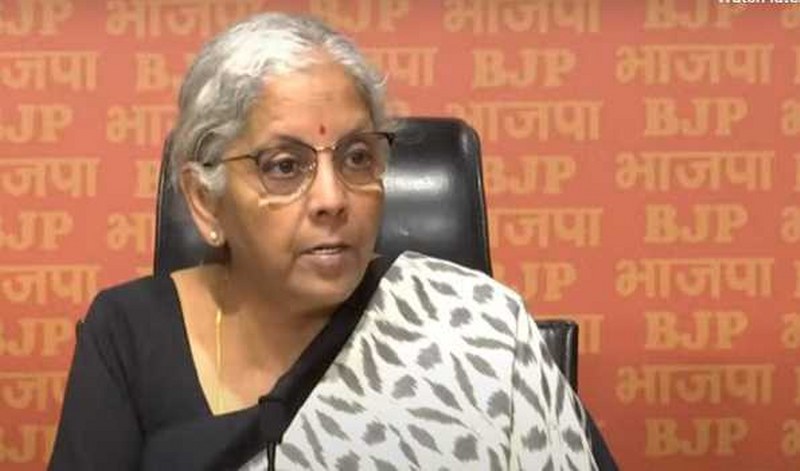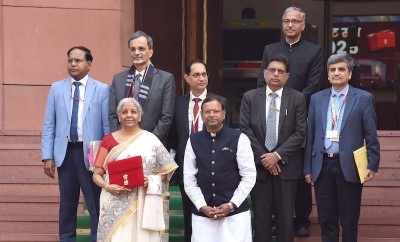
‘Seeds’ of the NPA crisis sown during UPA regime, IBC addressed the issue effectively: Sitharaman
New Delhi: The ‘seeds’ of the NPA crisis were sown during the Congress-led UPA era through ‘phone banking’, when loans were given to undeserving businesses under pressure from UPA leaders and party functionaries. Banks were forced to neglect proper due diligence and risk assessment before sanctioning these loans, Finance Minister Nirmala Sitharaman said on X.
In a series of posts on Friday, Sitharaman highlighted the turnaround in India’s banking system during NDA rule and accused the Congress-led UPA government of poor management and cronyism, leading to mammoth scams and massive NPAs.
“The ‘seeds’ of the NPA crisis were sown during the @INCIndia-led UPA era through ‘Phone Banking’, when loans were given to undeserving businesses under pressure from UPA leaders and party functionaries. Under the UPA, obtaining loans from banks often depended on powerful connections rather than a solid business proposition.
She alleged that the banks were forced to neglect proper due diligence and risk assessment before sanctioning these loans.
“This led to a massive increase in Non-Performing Assets (NPAs) and institutionalised grafts. Many banks hid and avoided reporting their bad loans by 'evergreening' or restructuring them,” she emphasised.
The finance minister said a slew of measures by the BJP-led NDA government and the RBI, such as the Asset Quality Review, disclosed hidden mountains of NPAs and ended the accounting tricks used to hide them.
“Congress-era reckless and imprudent lending created the disgraceful legacy of the ‘Twin Balance Sheet’ problem, which we inherited in 2014. This problem starved the nation of essential credit flow needed for development. Banks became reluctant to lend to new borrowers, especially MSMEs, the backbone of economic growth and job creation,” she stated.
Credit growth slowed to a decade-low level. Banks also suffered huge losses and erosion of capital due to higher provisioning.
After banks began transparently disclosing their NPAs for loans lent before 2014, the gross NPAs of PSBs rose to a high of 14.6% in FY 2017-18.
“Two former RBI Governors have openly exposed the level of decay in the system left by the UPA regime. Raghuram Rajan, who also participated in @RahulGandhi’s ‘Bharat Jodo Yatra’, described the NPA crisis during the UPA era as a “historic phenomenon of irrational exuberance. Similarly, former Governor Urjit Patel noted that the functioning of PSBs under the UPA suffered from ‘a perennial shortcoming on account of bureaucratic inertia and political meddling,’” she pointed out.
Insolvency and Bankruptcy Code (IBC)
Sitharaman alleged that amid the mounting NPAs, there was grave necessity to enact insolvency laws but the Congress turned a blind eye to its crying need.
The Narendra Modi government introduced the Insolvency and Bankruptcy Code (IBC) in 2016 to address the need for a modern corporate insolvency regime as highlighted by many expert groups over the years, she said.
Before IBC, corporate distress proceedings were governed by a patchwork of legislations, which worsened rather than resolving issues.
“Despite the crying need for enacting insolvency laws, the UPA regime consciously sought to reward its cronies at the cost of the banks and operational creditors who had to run from pillar to post for recovering their dues,” she said
Emphasising IBC’s positive role in curbing NPAs, she said, “The IBC has played a key role in helping banks recover from the NPA crisis created by @INCIndia and its allies during the UPA year through ‘phone banking’ and indiscriminate lending. IBC has built trust and transparency in the financial system.”
Prior to the Insolvency and Bankruptcy Code (IBC) introduced by PM Shri @narendramodi- led Government in 2016, corporate distress proceedings were governed by a patchwork of legislations, which worsened rather than resolving issues.
— Nirmala Sitharaman (Modi Ka Parivar) (@nsitharaman) May 30, 2024
The need for a modern corporate insolvency… pic.twitter.com/tucS8IFCPG
According to a report of the @RBI , the IBC continued as the key mechanism for banks to recover stressed assets – accounting by far for the greatest recovery among different channels in 2022-23 (43% of the total amount recovered), she said.
Post implementation of IBC, the gross non-performing assets (GNPA) ratio of Scheduled Commercial Banks dipped to a multi-year low of 3% and the net non-performing assets (NNPA) ratio to 0.7% (as of December 2023). By laying down governance norms for companies in distress, the IBC has taken corporate governance to new heights in the country.
She said that the credible threat that the resolution process under IBC could take the defaulting company away from the current promoters/management has resulted in better corporate governance.
The Supreme Court, while upholding the constitutional validity of the IBC in 2019, observed that: “…the experiment conducted in enacting the Code is proving to be largely successful. The defaulter's paradise is lost. In its place, the economy's rightful position has been regained”.
Each of the subsequent amendments, whenever challenged, has passed the test of constitutional norms.
"The IBC framework is continually evolving to ensure that it can meet the evolving needs of a rapidly growing economy. Our government has taken numerous steps to strengthen the insolvency framework and ensure resolutions happen in a timely manner. We remain committed to strengthening capacities of NCLT and NCLAT across the nation by expeditiously filling vacancies," she stated.
The emerging cadre of regulated insolvency and valuation professionals play a crucial role in driving these efforts as well, she said.
In the brief span of 8 years since the IBC's enactment, the industry has developed around 4,400 insolvency professionals and 5,500 registered valuers, Sithraman informed.
“Legislations like IBC are a testament to the far-reaching vision and foresight of the PM Shri @narendramodi -led government. Having been freed of the red tape of the UPA-era archaic legislation, the entire economy is reaping the benefits of this landmark legislation today,” she added.
Support Our Journalism
We cannot do without you.. your contribution supports unbiased journalism
IBNS is not driven by any ism- not wokeism, not racism, not skewed secularism, not hyper right-wing or left liberal ideals, nor by any hardline religious beliefs or hyper nationalism. We want to serve you good old objective news, as they are. We do not judge or preach. We let people decide for themselves. We only try to present factual and well-sourced news.







